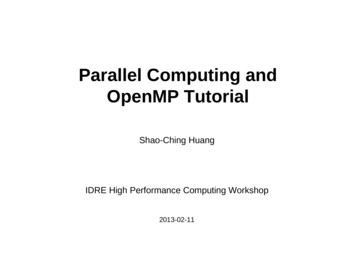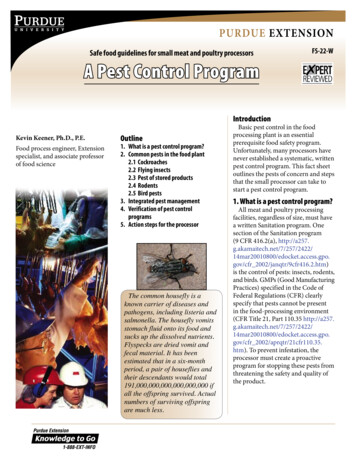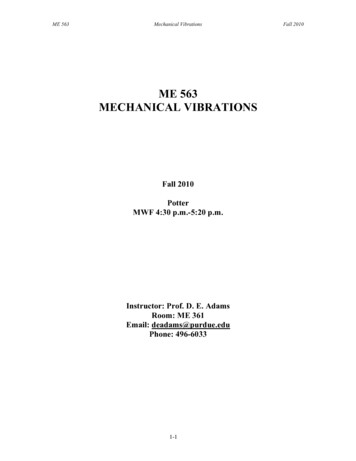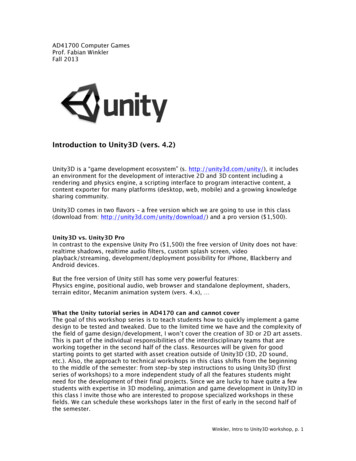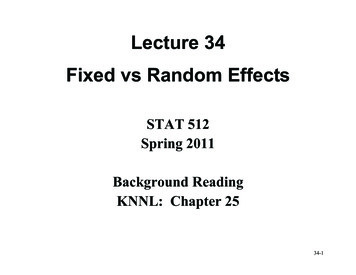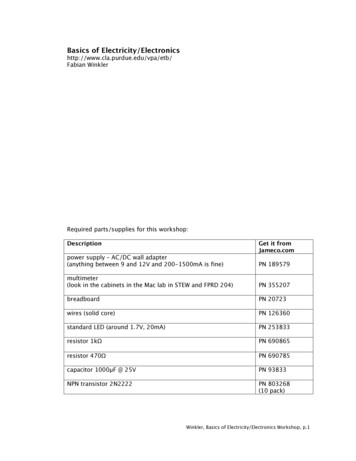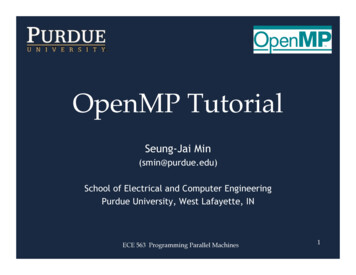
Transcription
OpenMP TutorialSeung-Jai Min(smin@purdue.edu)School of Electrical and Computer EngineeringPurdue University, West Lafayette, INECE 563 Programming Parallel Machines1
Parallel Programming Standards Thread Libraries- Win32 API / Posix threadsOUR FOCUS Compiler Directives- OpenMP (Shared memory programming) Message Passing Libraries- MPI (Distributed memory programming)ECE 563 Programming Parallel Machines2
Shared Memory ParallelProgramming in the Multi-Core Era Desktop and Laptop– 2, 4, 8 cores and ? A single node in distributed memory clusters– Steele cluster node: 2 8 (16) cores Shared memory hardware Accelerators Cell processors: 1 PPE and 8 SPEs Nvidia Quadro GPUs: 128 processing unitsECE 563 Programming Parallel Machines3
OpenMP:Some syntax details to get us started Most of the constructs in OpenMP are compilerdirectives or pragmas.– For C and C , the pragmas take the form:#pragma omp construct [clause [clause] ]– For Fortran, the directives take one of the forms:C OMP construct [clause [clause] ]! OMP construct [clause [clause] ]* OMP construct [clause [clause] ] Include files#include “omp.h”ECE 563 Programming Parallel Machines4
How is OpenMP typically used? OpenMP is usually used to parallelize loops: Find your most time consuming loops. Split them up between threads.Sequential Programvoid main(){int i, k, N 1000;double A[N], B[N], C[N];for (i 0; i N; i ) {A[i] B[i] k*C[i]}}Parallel Program#include “omp.h”void main(){int i, k, N 1000;double A[N], B[N], C[N];#pragma omp parallel forfor (i 0; i N; i ) {A[i] B[i] k*C[i];}}ECE 563 Programming Parallel Machines5
How is OpenMP typically used?(Cont.) Single Program Multiple Data (SPMD)Parallel Program#include “omp.h”void main(){int i, k, N 1000;double A[N], B[N], C[N];#pragma omp parallel forfor (i 0; i N; i ) {A[i] B[i] k*C[i];}}ECE 563 Programming Parallel Machines6
How is OpenMP typically used?(Cont.) Single Program Multiple Data (SPMD)Thread 0Thread 1void main()Thread 2void main(){Thread 3void main(){int i, k, N 1000;void main(){int i,C[N];k, N 1000;double A[N], B[N],{int i,C[N];k, N 1000;double A[N], B[N],lb 0;int i,C[N];k, N 1000;double A[N], B[N],lb 250;ub 250;double A[N], B[N], C[N];lb 500;ub 500;for (i lb;i ub;i ){lb 750;ub 750;(i lb;i ub;i ){A[i] B[i] for k*C[i];ub 1000;(i lb;i ub;i ){A[i] B[i] for k*C[i];}(i lb;i ub;i ) {A[i] B[i] for k*C[i];}}A[i] B[i] k*C[i];}}}}}ECE 563 Programming Parallel Machines7
OpenMP Fork-and-Join modelprintf(“program begin\n”);N 1000;#pragma omp parallel forfor (i 0; i N; i )A[i] B[i] C[i];SerialParallelSerialM 500;#pragma omp parallel forfor (j 0; j M; j )p[j] q[j] – r[j];printf(“program done\n”);ParallelSerialECE 563 Programming Parallel Machines8
OpenMP Constructs1.Parallel Regions–2.#pragma omp parallelWorksharing–3.#pragma omp for, #pragma omp sectionsData Environment–4.#pragma omp parallel shared/private ( )Synchronization–5.#pragma omp barrierRuntime functions/environment variables––int my thread id omp get num threads();omp set num threads(8);ECE 563 Programming Parallel Machines9
OpenMP: Structured blocks Most OpenMP constructs apply to structuredblocks.– Structured block: one point of entry at the top andone point of exit at the bottom.– The only “branches” allowed are STOP statements inFortran and exit() in C/C .ECE 563 Programming Parallel Machines10
OpenMP: Structured blocksA Structured Block#pragma omp parallel{more: do big job(id);if( count 1) goto more;}printf(“ All done \n”);Not A Structured Blockif(count 1) goto more;#pragma omp parallel{more: do big job(id);if( count 1) goto done;}done:if(!really done()) goto more;ECE 563 Programming Parallel Machines11
Structured Block Boundaries In C/C : a block is a single statement or a group ofstatements between brackets {}#pragma omp parallel{id omp thread num();A[id] big compute(id);}#pragma omp forfor (I 0;I N;I ) {res[I] big calc(I);A[I] B[I] res[I];}ECE 563 Programming Parallel Machines12
Structured Block Boundaries In Fortran: a block is a single statement or a group ofstatements between directive/end-directive pairs.C OMP PARALLEL10W(id) garbage(id)res(id) W(id)**2if(res(id) goto 10C OMP END PARALLELC OMP PARALLEL DOdo I 1,Nres(I) bigComp(I)end doC OMP END PARALLEL DOECE 563 Programming Parallel Machines13
OpenMP Parallel Regionsdouble A[1000];omp set num threads(4)A singlecopy of “A”is sharedbetween allthreads.pooh(0,A)double A[1000];omp set num threads(4);#pragma omp parallel{int ID omp get thread num();pooh(ID, A);}printf(“all done\n”);pooh(1,A)printf(“all done\n”);pooh(2,A)pooh(3,A)Implicit barrier: threads wait here forall threads to finish before proceedingECE 563 Programming Parallel Machines14
The OpenMP APICombined parallel work-share OpenMP shortcut: Put the “parallel” and thework-share on the same lineint i;double res[MAX];#pragma omp parallel{#pragma omp forfor (i 0;i MAX; i ) {res[i] huge();}}int i;double res[MAX];#pragma omp parallel forfor (i 0;i MAX; i ) {res[i] huge();}the same OpenMPECE 563 Programming Parallel Machines15
Shared Memory d3thread5thread4privateprivate Data can be shared orprivate Shared data is accessibleby all threads Private data can beaccessed only by thethread that owns it Data transfer is transparentto the programmerprivateECE 563 Programming Parallel Machines16
Data Environment:Default storage attributes Shared Memory programming model– Variables are shared by default Distributed Memory Programming Model– All variables are privateECE 563 Programming Parallel Machines17
Data Environment:Default storage attributes Global variables are SHARED among threads– Fortran: COMMON blocks, SAVE variables, MODULE variables– C: File scope variables, static But not everything is shared.– Stack variables in sub-programs called from parallel regionsare PRIVATE– Automatic variables within a statement block are PRIVATE.ECE 563 Programming Parallel Machines18
Data Environmentint A[100]; /* (Global) SHARED */int foo(int x){/* PRIVATE */int count 0;return x*count;}int main(){int ii, jj;/* PRIVATE */int B[100]; /* SHARED */#pragma omp parallel private(jj){int kk 1;/* PRIVATE */#pragma omp forfor (ii 0; ii N; ii )for (jj 0; jj N; jj )A[ii][jj] foo(B[ii][jj]);}}ECE 563 Programming Parallel Machines19
Work Sharing ConstructLoop Construct#pragma omp for [clause[[,] clause ] new-linefor-loopsWhere clause is one of the following:private / firstprivate / lastprivate(list)reduction(operator: list)schedule(kind[, chunk size])collapse(n)orderednowaitECE 563 Programming Parallel Machines20
Schedulefor (i 0; i 1100; i )A[i] ;#pragma omp parallel for schedule (static, 250) or (static)250250250250100 or275275275275p0p1p2p3p0p0p1p2p3#pragma omp parallel for schedule (dynamic, 200)200200200200200100p3p0p2p3p1p0#pragma omp parallel for schedule (guided, 100)137120p0p3105 100 100 100 100 100 100 100 38p0p1 p2 p3 p0 p1 p2 p3 p0#pragma omp parallel for schedule (auto)ECE 563 Programming Parallel Machines21
Critical Constructsum 0;#pragma omp parallel private (lsum){lsum 0;#pragma omp forfor (i 0; i N; i ) {lsum lsum A[i];}#pragma omp critical{ sum lsum; }Threads wait their turn;}only one thread at a timeexecutes the critical sectionECE 563 Programming Parallel Machines22
Reduction ClauseShared variablesum 0;#pragma omp parallel for reduction ( :sum)for (i 0; i N; i ){sum sum A[i];}ECE 563 Programming Parallel Machines23
Performance Evaluation How do we measure performance? (orhow do we remove noise?)#define N 24000For (k 0; k 10; k ){#pragma omp parallel for private(i, j)for (i 1; i N-1; i )for (j 1; j N-1; j )a[i][j] (b[i][j-1] b[i][j 1])/2.0;}ECE 563 Programming Parallel Machines24
Performance IssuesSpeedup What if you seea speedup saturation?1246# CPUs8#define N 12000#pragma omp parallel for private(j)for (i 1; i N-1; i )for (j 1; j N-1; j )a[i][j] (b[i][j-1] b[i][j] b[i][j 1]b[i-1][j] b[i 1][j])/5.0;ECE 563 Programming Parallel Machines25
Performance IssuesSpeedup What if you seea speedup saturation?12468# CPUs#define N 12000#pragma omp parallel for private(j)for (i 1; i N-1; i )for (j 1; j N-1; j )a[i][j] b[i][j];ECE 563 Programming Parallel Machines26
Loop Scheduling Any guideline for a chunk size?#define N big-number chunk ?;#pragma omp parallel for schedule (static, chunk)for (i 1; i N-1; i )a[i][j] ( b[i-2] b[i-1] b[i]b[i 1] b[i 2] )/5.0;ECE 563 Programming Parallel Machines27
Performance Issues Load imbalance: triangular access pattern#define N 12000#pragma omp parallel for private(j)for (i 1; i N-1; i )for (j i; j N-1; j )a[i][j] (b[i][j-1] b[i][j] b[i][j 1]b[i-1][j] b[i 1][j])/5.0;ECE 563 Programming Parallel Machines28
Summary OpenMP has advantages– Incremental parallelization– Compared to MPI No data partitioning No communication schedulingECE 563 Programming Parallel Machines29
/resourcesECE 563 Programming Parallel Machines30
OpenMP Tutorial Seung-Jai Min (smin@purdue.edu) School of Electrical and Computer Engineering Purdue University, West Lafayette, IN. . –For C and C , the pragmas take
